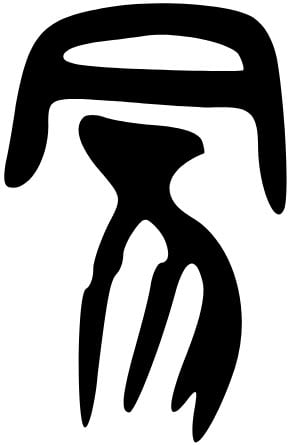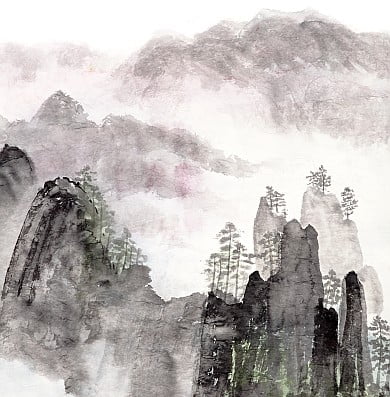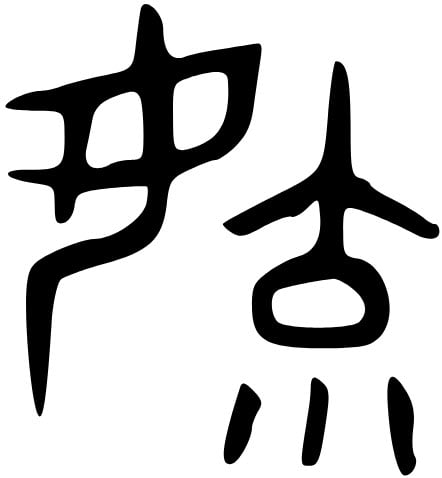When you’re looking at a hexagram through the lens of its trigrams, I think it’s important to see how they work together, as a trigram picture rather than a dry list of attributes. However, it’s still interesting to single out a trigram and a position (inside or outside), to compare the different ways it can interact.
Mountain, for instance, is the outer trigram of hexagrams 4, 18, 22, 23, 26, 27, 41 and 52. Here’s what it looks like in the first two of those:
Hexagram 4 and its mountain
This is the first mountain to appear in the Sequence of Hexagrams, rising above the stream. And as befits an introduction, its role here is quite plain. One of the meanings of the hexagram name, meng, is ‘cover’, and the early form of the character shows a pig under a cover:

(If you can’t quite see the pig there, here’s some help from LiSe.) And if you turn to the Shuogua, you learn that,
Qian is a horse, Kun is an ox;
Richard Rutt, Zhouyi
Zhen is a dragon, Xun is a cock;
Kan is a pig, Li is a pheasant;
Gen is a dog, Dui is a sheep.
So this turns out to be one of those wonderful hexagrams whose shape corresponds exactly to its name: the inner trigram is the pig from the meng character, and the outer trigram, mountain, is the cover. (Of course, the Shuogua authors may have learned that ‘kan is a pig’ by looking at Hexagram 4.)
This mountain-cover can be protective. The character also normally has a ‘plant’ component above the cover, so that LiSe once suggested the pig might be a piglet whose mother pushed it into the undergrowth to hide it.
It could also be a source. A stream under a mountain, like the one in Hexagram 4’s trigram picture, would have its source high up in the mountain’s gathered rain- and meltwater.
And it can be an obstacle. After all, the primary meaning of meng in divination is ignorance: obscured awareness; something getting in the way. If the same word is written with an added ‘water’ component, it means drizzle or mist. With ‘moon’ added, it means dim moonlight; with ‘eye’, it means blindness. For a vivid picture of this ‘obscuring’ in action, see ‘Not Knowing about dodder’. (‘Dodder’ may well be the character’s oldest meaning.)
It’s tempting to identify this obstacle with the speaker’s refusal to answer repeated questions in the Oracle. That certainly feels like a solid, mountainous ‘Stop’ sign. But there’s also the block-headedness that makes us keep asking, instead of listening.
So Hexagram 4’s mountain is an obstacle, a cover that obscures – and also one that shelters, and a source of wisdom. That’s quite reminiscent of the speaker of the Oracle, who both favours you with a clear answer and also obstructs your repeated questioning. A tutelary mountain?
Hexagram 18 and its mountain
Mountain’s next appearance as an outer trigram (after a brief interlude as bedrock in Hexagram 15) comes in Hexagram 18, Corruption: mountain above wind.
Here, too, the mountain is containing the inner trigram – putting a lid on it, as it were. The name of the hexagram, gu, meant a form of dark magic made with venomous creatures in a vessel. Even though the character doesn’t show the lid on the pot, we know there must be one, to trap them inside.
In the same way, around the world, wind that’s trapped below the mountains has a reputation for being unwholesome, ‘bad air’. And when we cast Hexagram 18, we think of corrupt patterns passed down through families – an oppressive weight of inheritance or tradition, and all things ‘set in stone’. 18’s mountain has all these associations.
Only… if we read beyond the name of the hexagram, Corruption actually turns out to be anything but stagnant:
‘Corruption. Creating success from the source.
Hexagram 18, the Oracle
Fruitful to cross the great river.
Before the seed day, three days. After the seed day, three days.’
A mountain is also (from the Shuogua again) a gate or boundary, and this one seems to be drawing a line between before and after. Hexagram 18 marks a moment when those old patterns can be changed.
The authors of the Image took the picture of ‘bad air’ under the mountain and transformed it:
‘Below the mountain is the wind. Corruption.
Hexagram 18, the Image
The noble one rouses the people to nurture character.’
The noble one is like wind, rousing the people, and like mountain, not trapping but nurturing. This is the exact same phrase that was used for Hexagram 4,
‘Below the mountain, spring water comes forth. Not Knowing.
Hexagram 4, the Image
A noble one nourishes character with the fruits of action.’
The noble one 育德 , yu de, nurtures and nourishes de. Yu, ‘nurtures’, originally means ‘gives birth to’ – interesting, when you think of wind or water flowing down from the summit – and by extension to nourish, rear, foster and educate. Again, the mountain above looks something like a mentor.
(More later on the other hexagrams!)











That was so inspiring, Hilary, thank you sooo much!